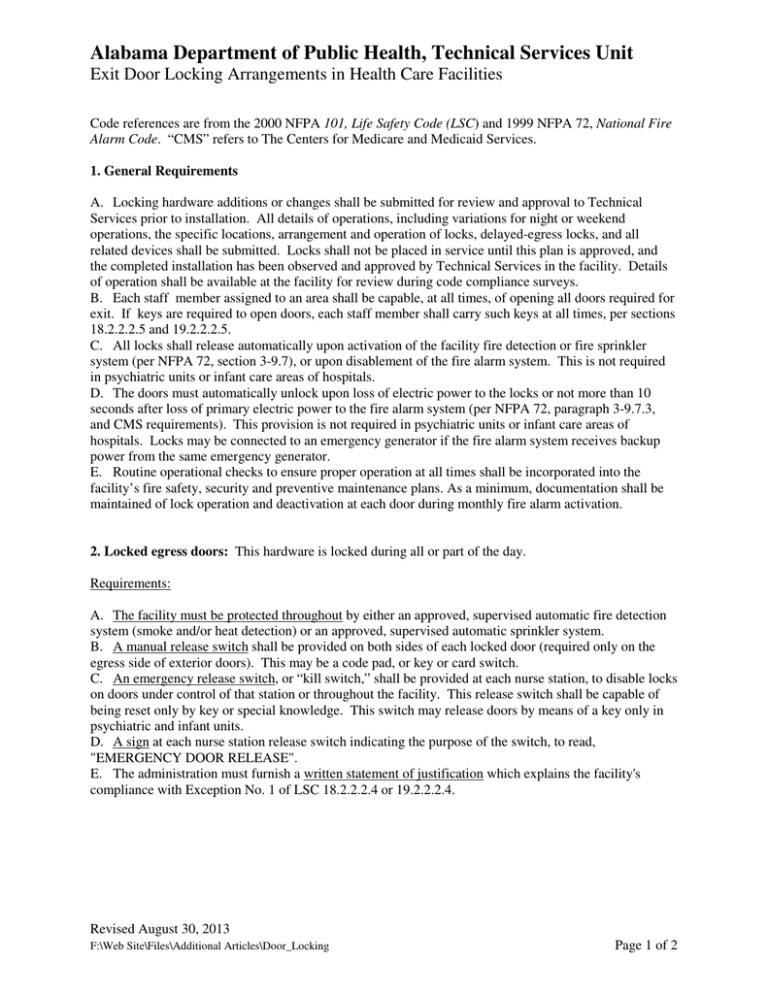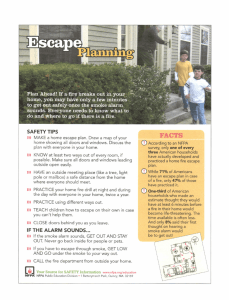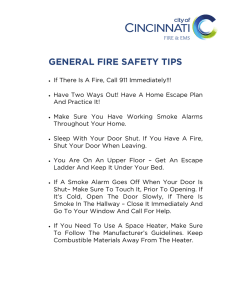Alabama Department of Public Health, Technical Services Unit
advertisement

Alabama Department of Public Health, Technical Services Unit Exit Door Locking Arrangements in Health Care Facilities Code references are from the 2000 NFPA 101, Life Safety Code (LSC) and 1999 NFPA 72, National Fire Alarm Code. “CMS” refers to The Centers for Medicare and Medicaid Services. 1. General Requirements A. Locking hardware additions or changes shall be submitted for review and approval to Technical Services prior to installation. All details of operations, including variations for night or weekend operations, the specific locations, arrangement and operation of locks, delayed-egress locks, and all related devices shall be submitted. Locks shall not be placed in service until this plan is approved, and the completed installation has been observed and approved by Technical Services in the facility. Details of operation shall be available at the facility for review during code compliance surveys. B. Each staff member assigned to an area shall be capable, at all times, of opening all doors required for exit. If keys are required to open doors, each staff member shall carry such keys at all times, per sections 18.2.2.2.5 and 19.2.2.2.5. C. All locks shall release automatically upon activation of the facility fire detection or fire sprinkler system (per NFPA 72, section 3-9.7), or upon disablement of the fire alarm system. This is not required in psychiatric units or infant care areas of hospitals. D. The doors must automatically unlock upon loss of electric power to the locks or not more than 10 seconds after loss of primary electric power to the fire alarm system (per NFPA 72, paragraph 3-9.7.3, and CMS requirements). This provision is not required in psychiatric units or infant care areas of hospitals. Locks may be connected to an emergency generator if the fire alarm system receives backup power from the same emergency generator. E. Routine operational checks to ensure proper operation at all times shall be incorporated into the facility’s fire safety, security and preventive maintenance plans. As a minimum, documentation shall be maintained of lock operation and deactivation at each door during monthly fire alarm activation. 2. Locked egress doors: This hardware is locked during all or part of the day. Requirements: A. The facility must be protected throughout by either an approved, supervised automatic fire detection system (smoke and/or heat detection) or an approved, supervised automatic sprinkler system. B. A manual release switch shall be provided on both sides of each locked door (required only on the egress side of exterior doors). This may be a code pad, or key or card switch. C. An emergency release switch, or “kill switch,” shall be provided at each nurse station, to disable locks on doors under control of that station or throughout the facility. This release switch shall be capable of being reset only by key or special knowledge. This switch may release doors by means of a key only in psychiatric and infant units. D. A sign at each nurse station release switch indicating the purpose of the switch, to read, "EMERGENCY DOOR RELEASE". E. The administration must furnish a written statement of justification which explains the facility's compliance with Exception No. 1 of LSC 18.2.2.2.4 or 19.2.2.2.4. Revised August 30, 2013 F:\Web Site\Files\Additional Articles\Door_Locking Page 1 of 2 Alabama Department of Public Health, Technical Services Unit Exit Door Locking Arrangements in Health Care Facilities 3. Delayed-egress door hardware: This hardware causes a 15-second delay to the deactivation of the lock, after 3 seconds of applied force. Requirements: A. Approved, listed, properly installed and programmed delayed-egress locks, arranged both in accordance with “Delayed-Egress Locks” in NFPA 101, Section 7.2.1.6.1 and the facility’s security and operational policies. B. 30-second delay: Approval may be granted upon written request from a facility for a delay of up to 30 seconds in sprinklered smoke compartments, per the exception to 7.2.1.6.1(c). 4. Bracelet locks (normally unlocked, with automatic locking or delayed-egress locking for selected individuals): This hardware operates with proximity detection of a bracelet worn by selected residents or patients. When the bracelet comes to within a set distance of the door, the door automatically locks. If the bracelet is moved away from the door, the door returns to its normally unlocked condition. Requirements: A. Corridor smoke detection if not sprinklered: Bracelet locking arrangements will be permitted in unsprinklered areas of buildings if there is a corridor smoke detection system, installed as part of the fire alarm system and complying with NFPA 101 and NFPA 72, throughout each affected unsprinklered smoke compartment. B. A manual release switch shall be provided on the egress side of, and adjacent to, each door. This may be a code pad or key switch. Contact Technical Services at 334-206-5177 with questions. Revised August 30, 2013 F:\Web Site\Files\Additional Articles\Door_Locking Page 2 of 2


